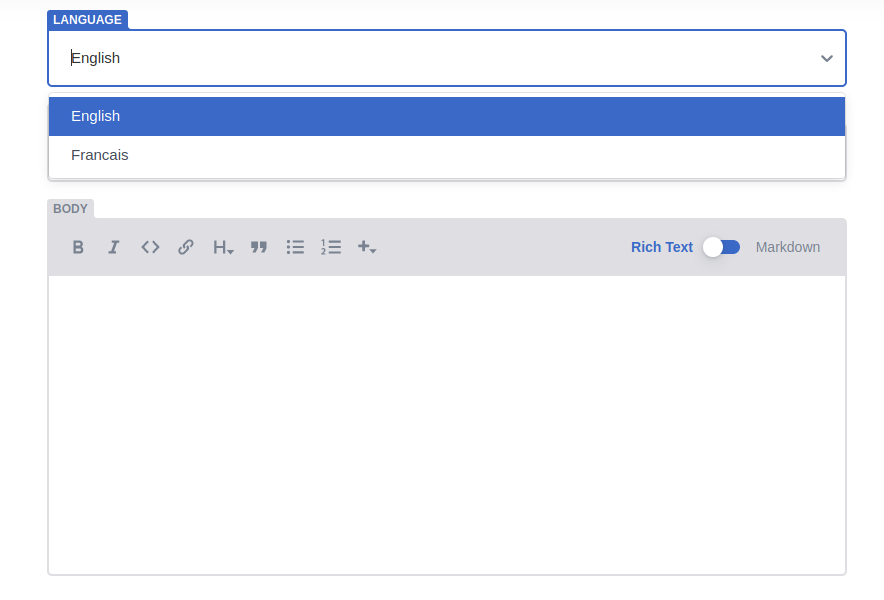https://github.com/tbille/multilingual-jekyll-netlify
This is a proof of concept of a multilingual Jekyll site with netlify-cms
https://github.com/tbille/multilingual-jekyll-netlify
jekyll netlify netlify-cms
Last synced: 8 months ago
JSON representation
This is a proof of concept of a multilingual Jekyll site with netlify-cms
- Host: GitHub
- URL: https://github.com/tbille/multilingual-jekyll-netlify
- Owner: tbille
- Created: 2020-03-30T21:22:13.000Z (over 5 years ago)
- Default Branch: master
- Last Pushed: 2022-07-22T05:47:18.000Z (over 3 years ago)
- Last Synced: 2025-03-24T02:22:40.934Z (9 months ago)
- Topics: jekyll, netlify, netlify-cms
- Language: HTML
- Homepage: https://youthful-stonebraker-b0e09f.netlify.com
- Size: 20.5 KB
- Stars: 12
- Watchers: 1
- Forks: 2
- Open Issues: 2
-
Metadata Files:
- Readme: README.md
Awesome Lists containing this project
README
# Multilingual Netlify CMS + Jekyll
[](https://app.netlify.com/sites/youthful-stonebraker-b0e09f/deploys)
This is a simple example of an implementation of a multilingual site using [Jekyll](https://jekyllrb.com/) + [netlify-cms](https://www.netlifycms.org/).

## How to run locally
**Optional:** In a terminal (to run the cms locally):
- `cd `
- `PORT=8076 npx netlify-cms-proxy-server`
In another terminal:
- `cd `
- `bundle exec jekyll serve`
- You can now access the site: http://localhost:4000
## How does it works?
This explanation is based on the idea that the reader has knowledge of both techonologies.
Netlify-cms gets linked to a collection languages that will define the laguages available (here limited by [this issue](https://github.com/netlify/netlify-cms/issues/800)):
``` yaml
- label: "Languages"
name: "languages"
folder: "_data/languages"
extension: "yml"
format: "yml"
create: false
slug: "{{code}}"
editor:
preview: false
fields:
- { label: "Language", name: "language" , widget: string}
- { label: "Country Code (for url)", name: "code" , widget: string}
```
This collection is located in the directory `_data/laguages` to allow the template to generate automatically the [list of available languages](https://github.com/tbille/multilingual-jekyll-netlify/blob/master/_includes/languages.html).
All the templates are located in the directory `_includes` in this example only `index.html` and `about.html`.
For every language there is a directory named by the code of the language: for example `fr`. This directory will contain all the layouts and include the corresponding template with the `lang` variable set as the code of the language. The [index in french](https://github.com/tbille/multilingual-jekyll-netlify/blob/master/fr/index.html) would look like this:
```
---
layout: default
---
{% include index.html lang="fr" %}
```
Once all this is setup let's have a look at the collections defined in [netlify-cms configuration file](https://github.com/tbille/multilingual-jekyll-netlify/blob/master/admin/config.yml#L24).
``` yaml
- label: "Post"
name: "post"
folder: "_posts"
slug: "{{year}}-{{month}}-{{day}}-{{title}}"
create: true
editor:
preview: false
fields:
- label: Language
name: language
widget: relation
collection: languages
searchFields: ["language"]
valueField: code
displayFields: ["language"]
default: "en"
- { label: "Title", name: "title", widget: "string" }
- { label: "Body", name: "body", widget: "markdown" }
```
Every collection have the field language which is a relation based on the list of languages. This allows the user to set a language for the content being written.
Every content created will have the variable `language` set in its frontmatter. This allows the templates to then [filter the relevant content](https://github.com/tbille/multilingual-jekyll-netlify/blob/master/_includes/index.html#L5) based on this variable.
*Et voilà !*
## Add a new language?
To add a new language, Italian for example:
- `touch _includes/languages/it.yaml`
- `$EDITOR _includes/languages/it.yaml`
- Insert this content:
```
language: Italiano
code: it
```
- `mkdir it`
- Add same the files that French (`fr/`) and change the variable `lang` to have the value `it`
## Change default language?
English has been set as default language. For that in each file contained in the language directory the line `permalink: /` needs to be added. This line can be removed from the previous default language.
## What next?
- [ ] Script add language
- [ ] Create a GitHub action to automatically add the directory with the templates when a new language is added from the cms
- [ ] Handle URL for posts (is it really useful??)
- [ ] Swaggify a bit the templates
With <3 from toto